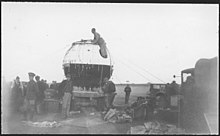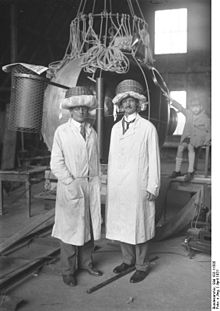
A hot air balloon is a lighter-than-air aircraft consisting of a bag, called an envelope, which contains heated air. Suspended beneath is a gondola or wicker basket, which carries passengers and a source of heat, in most cases an open flame caused by burning liquid propane. The heated air inside the envelope makes it buoyant, since it has a lower density than the colder air outside the envelope. As with all aircraft, hot air balloons cannot fly beyond the atmosphere. The envelope does not have to be sealed at the bottom, since the air inside the envelope is at about the same pressure as the surrounding air. In modern sport balloons the envelope is generally made from nylon fabric, and the inlet of the balloon is made from a fire-resistant material such as Nomex. Modern balloons have been made in many shapes, such as rocket ships and the shapes of various commercial products, though the traditional shape is used for most non-commercial and many commercial applications.

The Fédération aéronautique internationale is the world governing body for air sports, and also stewards definitions regarding human spaceflight. It was founded on 14 October 1905, and is headquartered in Lausanne, Switzerland. It maintains world records for aeronautical activities, including ballooning, aeromodeling, and unmanned aerial vehicles (drones), as well as flights into space.

In aeronautics, a balloon is an unpowered aerostat, which remains aloft or floats due to its buoyancy. A balloon may be free, moving with the wind, or tethered to a fixed point. It is distinct from an airship, which is a powered aerostat that can propel itself through the air in a controlled manner.

Project Excelsior was a series of parachute jumps made by Joseph Kittinger of the United States Air Force in 1959 and 1960 from helium balloons in the stratosphere. The purpose was to test the Beaupre multi-stage parachute system intended to be used by pilots ejecting from high altitude. In one of these jumps Kittinger set world records for the longest parachute drogue fall, the highest parachute jump, and the fastest speed by a human through the atmosphere. He held the latter two of these records for 52 years, until they were broken by Felix Baumgartner of the Red Bull Stratos project in 2012, though he still holds the world record for longest time in free fall.

Perlan Project Inc. is a 501(c)(3) not-for-profit aeronautical exploration and atmospheric science research organization that utilizes sailplanes (gliders) designed to fly at extremely high altitudes.

The Mil V-12, given the project number Izdeliye 65, is a prototype helicopter designed in the Soviet Union and the largest helicopter ever built. The designation "Mi-12" would have been the designation for the production helicopter and did not apply to V-12 prototypes.

Einar K. Enevoldson was the director of the Perlan Project. He was a civilian research pilot for NASA's Hugh L. Dryden Flight Research Center, Edwards, California, from 1968 until 1986. He was involved in many research programs, including those with experimental wings, propulsion and digital computer flight control systems.

The Myasishchev M-55 is a high-altitude reconnaissance aircraft developed by OKB Myasishchev in the Soviet Union, similar in mission to the Lockheed ER-2, but with a twin-boom fuselage and tail surface design. It is a twin-engined development of the Myasishchev M-17 Stratosphera with a higher maximum take-off weight.

Lieutenant Commander Victor Alonzo Prather Jr. was an American flight surgeon famous for taking part in "Project RAM", a government project to develop the space suit. On May 4, 1961, Prather drowned during the helicopter transfer after the landing of the Strato-Lab V balloon flight, which set an altitude record for manned balloon flight which stood until 2012.

Felix Baumgartner is an Austrian skydiver, daredevil and BASE jumper. He is widely known for jumping to Earth from a helium balloon from the stratosphere on 14 October 2012 and landing in New Mexico, United States, as part of the Red Bull Stratos project. Doing so, he set world records for skydiving an estimated 39 km (24 mi), reaching an estimated top speed of 1,357.64 km/h (843.6 mph), or Mach 1.25. He became the first person to break the sound barrier relative to the surface without vehicular power on his descent. He broke skydiving records for exit altitude, vertical freefall distance without a drogue parachute, and vertical speed without a drogue. Though he still holds the two latter records, the first was broken two years later, when on 24 October 2014, Alan Eustace jumped from 135,890 feet with a drogue.

Malcolm David Ross was a captain in the United States Naval Reserve (USNR), an atmospheric scientist, and a balloonist who set several records for altitude and scientific inquiry, with more than 100 hours flight time in gas balloons by 1961. Along with Lieutenant Commander Victor A. Prather (USN), he set the altitude record for a manned balloon flight.

Breitling Orbiter was the name of three different Rozière balloons made by the Bristol based balloon manufacturer Cameron Balloons to circumnavigate the globe, named after the Swiss watchmakers Breitling. The third was successful in March 1999 of making the first nonstop flight around the world by balloon. It was piloted by Bertrand Piccard and Brian Jones.

Similar to skydiving, space diving is the act of jumping from an aircraft or spacecraft in near space and falling towards Earth. The Kármán line is a common definition as to where space begins, 100 km (62 mi) above sea level. This definition is accepted by the Fédération Aéronautique Internationale (FAI), which is an international standard setting and record-keeping body for aeronautics and astronautics. The United States Air Force uses 50 mi (80 km) to award astronaut wings.

Les Frères Robert were two French brothers. Anne-Jean Robert (1758–1820) and Nicolas-Louis Robert (1760–1820) were the engineers who built the world's first hydrogen balloon for professor Jacques Charles, which flew from central Paris on 27 August 1783. They went on to build the world's first manned hydrogen balloon, and on 1 December 1783 Nicolas-Louis accompanied Jacques Charles on a 2-hour, 5-minute flight. Their barometer and thermometer made it the first balloon flight to provide meteorological measurements of the atmosphere above the Earth's surface.

Nicholas John Piantanida was an American amateur parachute jumper who reached 123,500 feet with his Strato Jump II balloon on February 2, 1966, flying a crewed balloon higher than anyone before, a record that stood until Felix Baumgartner's flight on October 14, 2012.
Red Bull Stratos was a high-altitude skydiving project involving Austrian skydiver Felix Baumgartner. On 14 October 2012, Baumgartner flew approximately 39 kilometres (24 mi) into the stratosphere over New Mexico, United States, in a helium balloon before free falling in a pressure suit and then parachuting to Earth. The total jump, from leaving the capsule to landing on the ground, lasted approximately ten minutes. While the free fall was initially expected to last between five and six minutes, Baumgartner deployed his parachute after 4 minutes and 19 seconds.
Jean Boulet was a French aviator. In 1957, Boulet was awarded the Aeronautical Medal; in 1983, he became one of the founding members of the French National Air and Space Academy. He died at the age of 90.

Hawthorne Charles Gray was a captain in the United States Army Air Corps. On May 4, 1927, he succeeded in setting a new altitude record in a silk, rubberized, and aluminum-coated balloon launched from Scott Field near Belleville, Illinois, reaching a human world altitude record of 42,470 ft (12.94 km). This record was not recognized by the FAI because Gray parachuted out of the balloon and did not land with his vehicle as per FAI rules. On November 4, 1927, Gray broke his own record by reaching more than 43,000 ft (13.1 km), but died during his descent after his oxygen supply became depleted. The record was recognized by the National Aeronautical Association, but not by the Fédération Aéronautique Internationale because the dead aeronaut "was not in personal possession of his instruments." Gray was posthumously awarded the Distinguished Flying Cross for his three ascents on March 9, May 4 and November 4.
The Two Eagles Balloon is a custom balloon designed to break world records. A January 2015 launch from Japan toward North America has officially broken two world records as validated by the Fédération Aéronautique Internationale.

Spirit of Freedom balloon was a Rozière balloon designed and built by Donald Cameron and Tim Cole. In 2002 solo pilot Steve Fossett flew the Spirit of Freedom to become the first successful around-the-world nonstop solo flight in any kind of aircraft. On June 19, 2002, the 10-story-high balloon Spirit of Freedom lifted off from Northam, Western Australia, and landed in Queensland, Australia, on July 3, 2002. The solo flight circumnavigation lasted 13 days, 8 hours, 33 minutes and covered 20,626.48 statute miles (33,195.10 km). During this flight, the balloon reached speeds of up to 322 kilometers per hour, and flew as high as 10,580 meters.

















